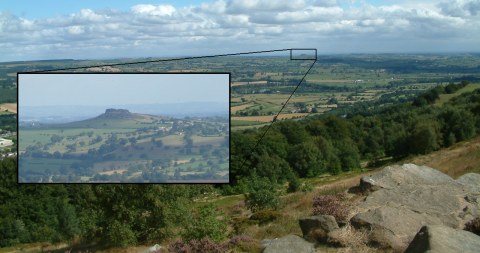



The name 'Chevin' is said to derive from the Celtic 'Cefyn' or 'Cefu' meaning a ridge: which exactly describes it...

The story of the Chevin begins some 350 million years ago when, early in the Earth's history, land masses looked very different from those we see today. At this time, 100 million years before the dinosaurs, and with land masses forming a single continent called Pangaea, sea levels rose and fell periodically. These rises and falls created thin mud layers populated by marine life which left evidence of their presence in the form of fossils, some of which are to be found in the rocks of the Chevin today.
Later, but still over 300 million years ago, rivers flowing out of mountainous lands to the north of where Britain is now, deposited layers of mud and sand over a wide and shallow delta within whose area Leeds and the Chevin are situated.
These successive layers of sediment were, in turn, eroded and re-deposited before being eventually buried and subjected to the great pressures which eventually hardened them into Millstone Grit.

Almscliff Crag
It was at around this time that, across to the north-east what was to be a further reminder of the Chevin's history, Almscliff Crag, a proud, upstanding mass of Millstone Grit, was formed as a consequence of an underwater landslip during the time of the grit's deposition.
Eventually, as continents moved and collided, the layers of rock were deformed and the Chevin, part of the long ridge from Addingham to Harewood, was created. Today, those grit and shale formations of the Carboniferous Millstone Grit Group dip down beneath Guiseley complete with bands of shale containing marine fossils, and sandy deposits containing plant remains. Below them all remains a core of older rocks which surfaces in the Skipton area and which was also compressed some 300 million years ago.
With the Chevin now formed, the story does not end. During the Ice Age the area, including the Chevin, was clothed in thick ice and the Wharfedale glacier reshaped the land over which it ground relentlessly. Evidence of this remains today in the form of limestone blocks which were transported from the Dales in the north by the arm of the glacier which moved through the 'Guiseley Gap' and deposited them near to Reva. Even more recently, just some 20000 years ago, with annual temperatures hovering around a chilly -6°C to -9°C, this area saw the last great advance of the Ice Age and it is possible that, once again, the Chevin was covered.
